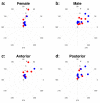Characterization of Uterine Motion in Early Gestation Using MRI-Based Motion Tracking
- PMID: 33086473
- PMCID: PMC7603139
- DOI: 10.3390/diagnostics10100840
Characterization of Uterine Motion in Early Gestation Using MRI-Based Motion Tracking
Abstract
Magnetic resonance imaging (MRI) is a promising non-invasive imaging technique that can be safely used to study placental development and function. However, studies of the human placenta performed by MRI are limited by uterine motion and motion in the uterus during MRI remains one of the major limiting factors. Here, we aimed to investigate the characterization of uterine activity during MRI in the second trimester of pregnancy using MRI-based motion tracking. In total, 46 pregnant women were scanned twice (first scan between 14 and 18 weeks and second scan between 19 and 24 weeks), and 20 pregnant subjects underwent a single MRI between 14 and 18 weeks GA, resulting in 112 MRI scans. An MRI-based algorithm was used to track uterine motion in the superior-inferior and left-right directions. Uterine contraction and maternal motion cases were separated by the experts, and unpaired Wilcoxon tests were performed within the groups of gestational age (GA), fetal sex, and placental location in terms of the overall intensity measures of the uterine activity. In total, 22.3% of cases had uterine contraction during MRI, which increased from 18.6% at 14-18 weeks to 26.4% at 19-24 weeks GA. The dominant direction of the uterine contraction and maternal motion was the superior to the inferior direction during early gestation.
Keywords: MRI motion tracking; human pregnancy; maternal motion; placenta MRI; uterine contraction.
Conflict of interest statement
The authors declare no conflict of interest.
Figures





Similar articles
-
Measuring human placental blood flow with multidelay 3D GRASE pseudocontinuous arterial spin labeling at 3T.J Magn Reson Imaging. 2018 Jun;47(6):1667-1676. doi: 10.1002/jmri.25893. Epub 2017 Nov 14. J Magn Reson Imaging. 2018. PMID: 29135072 Free PMC article.
-
3D mapping of the placenta during early gestation using free-breathing multiecho stack-of-radial MRI at 3T.J Magn Reson Imaging. 2019 Jan;49(1):291-303. doi: 10.1002/jmri.26203. Epub 2018 Aug 24. J Magn Reson Imaging. 2019. PMID: 30142239 Free PMC article.
-
A retrospective segmentation analysis of placental volume by magnetic resonance imaging from first trimester to term gestation.Pediatr Radiol. 2018 Dec;48(13):1936-1944. doi: 10.1007/s00247-018-4213-x. Epub 2018 Jul 20. Pediatr Radiol. 2018. PMID: 30027370
-
Association of placental perfusion, as assessed by magnetic resonance imaging and uterine artery Doppler ultrasound, and its relationship to pregnancy outcome.Placenta. 2013 Oct;34(10):885-91. doi: 10.1016/j.placenta.2013.07.006. Epub 2013 Aug 9. Placenta. 2013. PMID: 23937958
-
Obstetrical complications associated with abnormal maternal serum markers analytes.J Obstet Gynaecol Can. 2008 Oct;30(10):918-932. doi: 10.1016/S1701-2163(16)32973-5. J Obstet Gynaecol Can. 2008. PMID: 19038077 Review. English, French.
Cited by
-
Impact of uterine displacement on T2-weighted image quality in the female pelvic MRI.Radiol Phys Technol. 2025 Mar;18(1):127-135. doi: 10.1007/s12194-024-00861-3. Epub 2024 Nov 26. Radiol Phys Technol. 2025. PMID: 39592558
-
Mechanobiology of the female reproductive system.Reprod Med Biol. 2021 Jul 31;20(4):371-401. doi: 10.1002/rmb2.12404. eCollection 2021 Oct. Reprod Med Biol. 2021. PMID: 34646066 Free PMC article. Review.
-
Utility of In Vivo Magnetic Resonance Imaging Is Predictive of Gestational Diabetes Mellitus During Early Pregnancy.J Clin Endocrinol Metab. 2023 Jan 17;108(2):281-294. doi: 10.1210/clinem/dgac602. J Clin Endocrinol Metab. 2023. PMID: 36251771 Free PMC article.
-
The human placenta project: Funded studies, imaging technologies, and future directions.Placenta. 2023 Oct;142:27-35. doi: 10.1016/j.placenta.2023.08.067. Epub 2023 Aug 21. Placenta. 2023. PMID: 37634371 Free PMC article. Review.
-
A Description of the Imaging Innovations for Placental Assessment in Response to Environmental Pollution Study.Am J Perinatol. 2024 May;41(S 01):e853-e862. doi: 10.1055/a-1961-2059. Epub 2022 Oct 14. Am J Perinatol. 2024. PMID: 36241211 Free PMC article.

